Arthur Conan Doyle, 1859–1930
Autograph letters to Jessie Drummond, 1882–1890
Mark Samuels Lasner Collection
These three letters to a member of a family Doyle came to know while studying medicine in Edinburgh give a lively account of his struggles to set up as a doctor in Southsea while at the same time trying to establish himself as an author. He writes at one point, “the practice is stagnant” and refers to several pre-Holmes writings: "...You will see a story of mine called 'The Captain of the Polestar' in the January (I think) Temple Bar. It ought to frighten you. I will not tell you of any other recent story for I have been getting among bad company, I fear, who used their adjectives somewhat freely as rough men will, and I should not like you to identify me with my characters….”
Arthur Conan Doyle, 1859–1930
Autograph letter to J. M. Stoddart, December 29, 1891
Mark Samuels Lasner Collection
In August 1889, a pair of up-and-coming authors were invited to dinner by James Marshall Stoddart, a Philadelphia publisher visiting London. Oscar Wilde and Arthur Conan Doyle enjoyed each other’s company and by the end of a meal that has become legend, Stoddart commissioned them to write novellas to be published in Lippincott’s Monthly Magazine. The result was Wilde’s The Picture of Dorian Gray and Doyle’s The Sign of the Four, the second appearance of Sherlock Holmes. Doyle and Stoddart kept up their connection, and in this letter, Doyle writes about a theme that permeates his work, the wish for a strong bond he wants to see between Britain and America. Concerning the novel he is writing, which became The Refugees, he explains that it will take place in France but have a “strong American tinge” and adds, “It is so pleasing to me I think that my little books have made friends over there. Have I some subtle distant strain of American blood, or why is it that my heart always warms so toward your great country.”
Arthur Conan Doyle, 1859–1930
The Refugees: A Tale of Two Continents. London : Longmans, Green, and Co., 1893
Presentation (dedication) copy from Doyle to his wife, Louisa
Mark Samuels Lasner Collection
Although Sherlock Holmes brought him fame and fortune, Doyle set greater store on his historical fiction, “serious” works which he hoped would embellish his reputation. Such novels as Micah Clark, The White Company, and Rodney Stone were well-received (and merit reading even today) but had nowhere near the success of Holmes. Like many of his contemporaries—think of Robert Louis Stevenson, Anthony Hope, and Stanley Weyman—Doyle was attracted to writing stories in which royals, ordinary citizens, honor, romance, travel, and swordplay appear, not always in equal measures. Set in the seventeenth century and with a broad scope encompassing the Court of Louis XIV and the transatlantic trials and tribulations of persecuted Huguenots as they leave France for the New World, The Refugees was an ambitious undertaking. First appearing in installments in Harper’s Magazine, the book was published as a “triple-decker” (a peculiarly Victorian form, suited for the circulating libraries) in May 1893. Doyle’s unusually intimate inscription, “with Arthur’s love” dated prior to publication suggests strongly that this was the dedication copy, presented to his wife, Louisa Hawkins, who was increasingly ill with tuberculosis.
Newsboy
Arthur Conan Doyle, albumen cabinet card, New York, [1894]
Mark Samuels Lasner Collection
Now internationally-known and someone who had long wanted to visit America, Doyle embarked on a speaking tour of the United States under the auspices of the impresario Major James B. Pond, the Civil War veteran who dominated the market for importing British lecturers. This photograph, taken shortly after Doyle’s arrival in New York, showed how widespread the interest was in the creator of Sherlock Holmes. It was included in the Newsboy series of celebrity cards, distributed as a premium by the National Newsboy Tobacco Company when customers purchased their products. However, it is unclear what role Doyle had in the distribution of these images or if he or Pond had authorized their production. Due to its cheap production quality, this photograph is something of a rarity, despite having been issued in large numbers.
Arthur Conan Doyle 1859-1930
North American Lecture: autograph manuscript and typescripts, 1894
Mark Samuels Lasner Collection
Travelling up and down the East Coast and as far west as Chicago, Doyle was interviewed by the press and feted by the literary and social elite while he delivered some thirty lectures to large and (mostly) appreciative audiences. Shrewdly, he gave his listeners what they wanted to hear— Sherlock Holmes. These forty pages of drafts, some in the Doyle’s hand, others corrected typescript (no complete authorial text survives), show how readings of passages from the Homes canon (“The Sign of the Four” and “The Greek Interpreter” are mentioned here) were integrated into an autobiographical account which touched also on Edgar Allan Poe and and referred to the recent, non-Holmes historical novels, The Refugees and The White Company. Present also in the fragments are portions of the two other lectures Doyle proposed to Pond, “Facts about Fiction” and “The Novels of George Meredith.”
Arthur Conan Doyle, 1859–1930
Round the Red Lamp: Being Facts and Facets of Medical Life. New York: D. Appleton and Co., 1894.
Presentation copy from Doyle to Major James B. Pond
Mark Samuels Lasner Collection
The title of this volume refers to the red lamp which, in Britain, traditionally identified a doctor’s office. Of the thirteen medical and fantasy stories, the most interesting are "The Third Generation," which brings up the taboo subject of syphilis, and “The Doctors of Hoyland,” in which a young woman physician (a rarity in the 1890s) saves the life of the older local general practitioner, but rejects his proposal of marriage, wishing to keep her independence. Doyle was giving a lecture in Norwich, Connecticut, on the day he presented this first American edition to Major Pond.
Arthur Conan Doyle, 1859–1930
Autograph letter to James B. Pond, October 22, 1894
Mark Samuels Lasner Collection
In this letter to the organizer of his American lecture tour, Doyle mentions several of his own stories and lectures, including “The Lord of Château Noir” and makes arrangements, writing, “I don’t want to go to Wellesley College, but I should wish to leave a wreath on Holmes’ grave.” The “Holmes” referred to is not Sherlock, but Oliver Wendell Holmes, author of The Autocrat of the Breakfast Table, and like Doyle a physician as well as a writer—and the likely source for the detective’s surname.
My First Book: The Experiences of Walter Besant, James Payn, W. Clark Russell, Grant Allen, Hall Caine, George R. Sims, Rudyard Kipling, A. Conan Doyle, M.E. Braddon, F.W. Robinson, H. Rider Haggard, R.M. Ballantyne, I. Zangwill, Morley Roberts, David Christie Murray, Marie Corelli, Jerome K. Jerome, John Strange Winter, Bret Hart, Robert Buchanan, Robert Louis Stevenson / with an Introduction by Jerome K. Jerome; and 185 Illustrations. London: Chatto and Windus, 1894.
Mark Samuels Lasner Collection
Doyle’s contribution to this omnibus of gossip recollections by popular authors of the day—only a few of them still famous today—told of a writing career that began at age six, matured decades later as Doyle contributed stories to periodicals when in need of money, and really began, after fits and starts, with the publication of Micah Clark in 1885, two years before Sherlock Holmes made his first appearance in A Study in Scarlet. “Juvenilia” had, like the other articles in the book, first appeared in The Idler, the magazine founded and edited by Doyle’s friend, Jerome K. Jerome, the author of the humor classic, Three Men in a Boat.

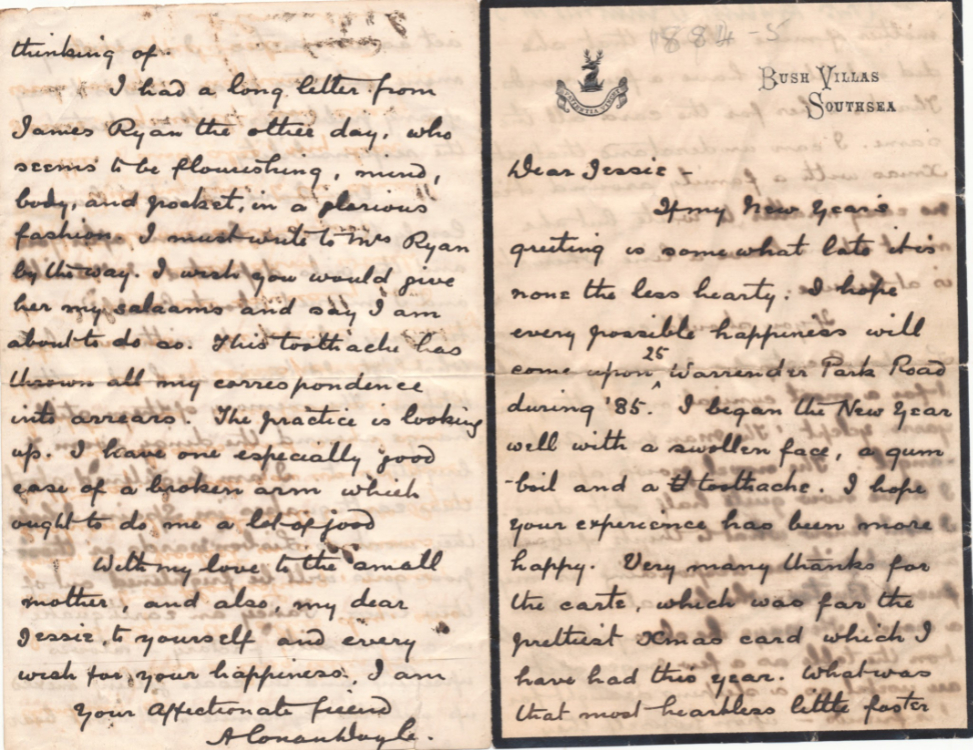
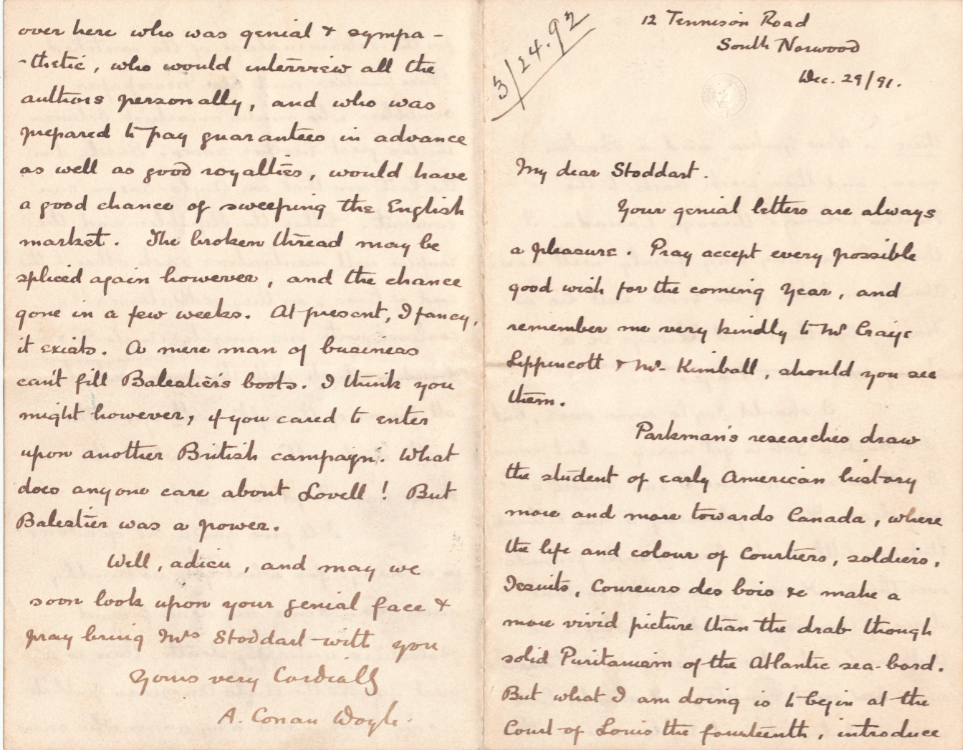
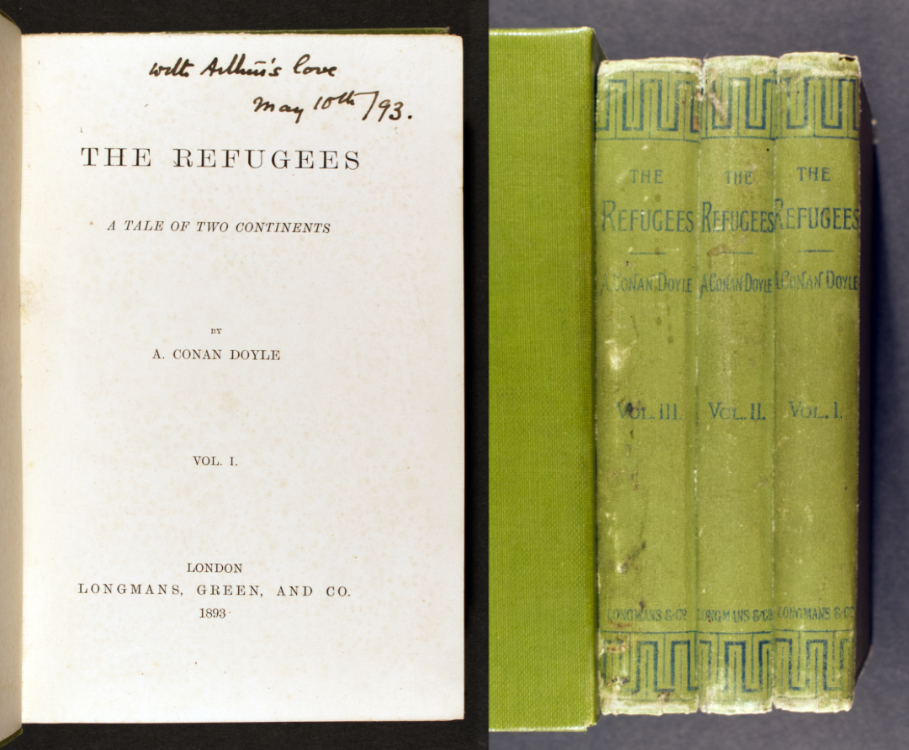
![Newsboy. Arthur Conan Doyle, albumen cabinet card, New York, [1894]. Mark Samuels Lasner Collection. Newsboy. Arthur Conan Doyle, albumen cabinet card, New York, [1894]. Mark Samuels Lasner Collection.](https://exhibitions.lib.udel.edu/sherlock/wp-content/uploads/sites/250/2021/09/photo.jpg)
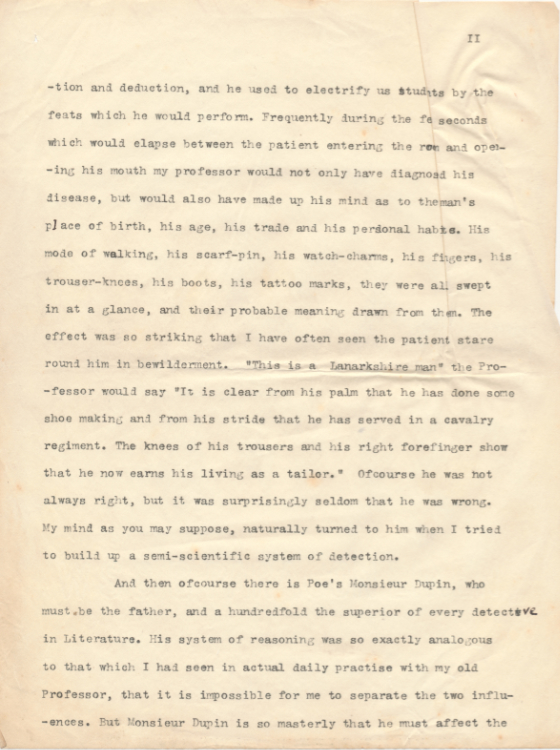
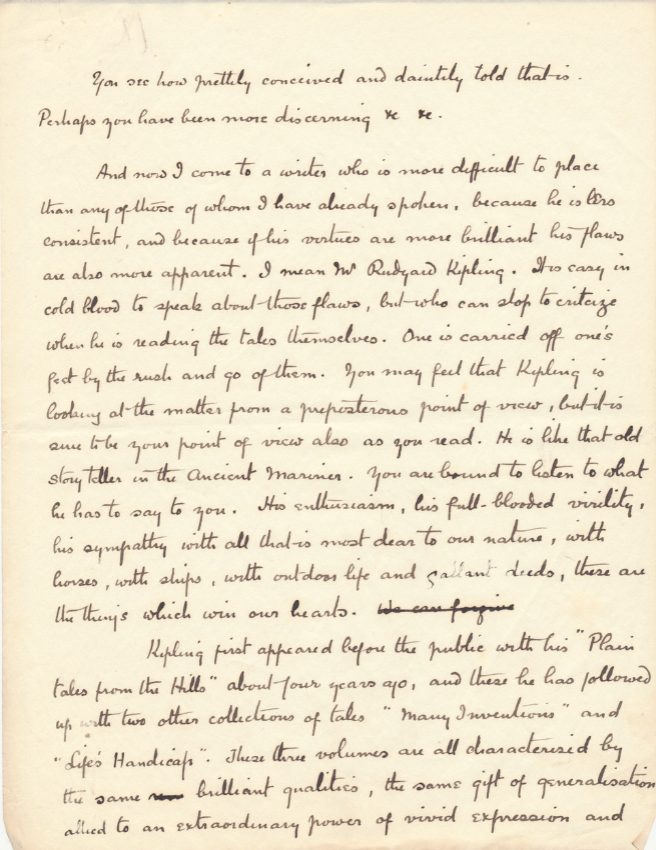
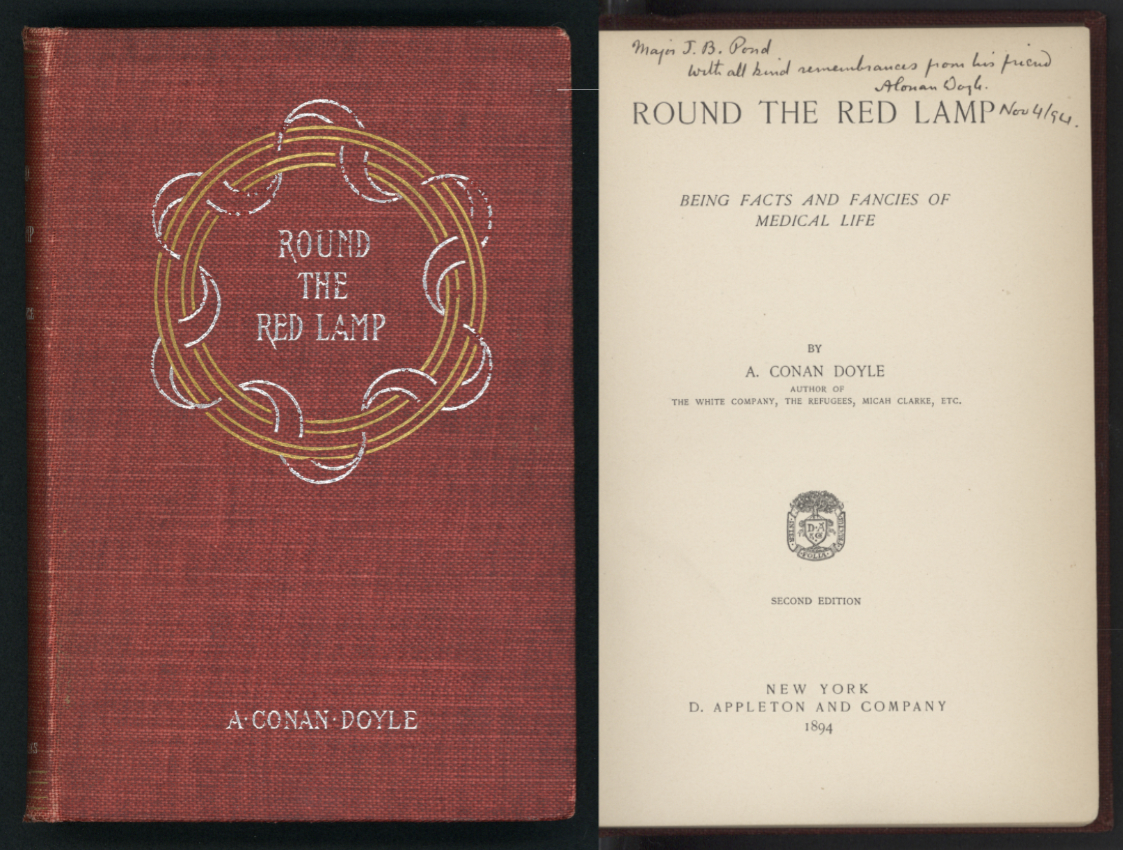
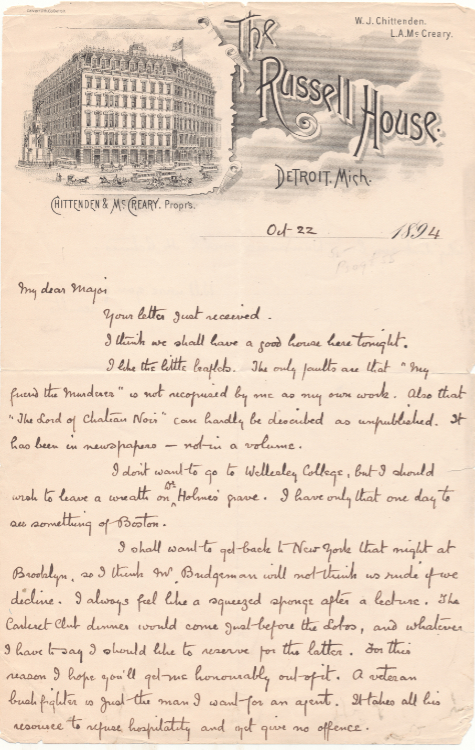
![My First Book: The Experiences of [various authors]. London: Chatto and Windus, 1894. Mark Samuels Lasner Collection. My First Book: The Experiences of [various authors]. London: Chatto and Windus, 1894. Mark Samuels Lasner Collection.](https://exhibitions.lib.udel.edu/sherlock/wp-content/uploads/sites/250/2021/09/first-book-bundle.jpg)
